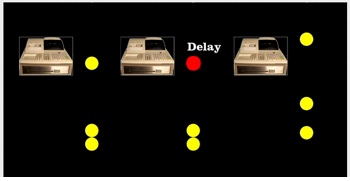- Decisions, decisions…
- Defining the Problem
- Decisions – Gathering information
- Decisions – Identify Limiting Factors and Constraints
- Decisions – Analyzing Possible Solutions
- Decisions – Making the Call
- Decision Making – Bad Call!
- Decisions – Your Need for Cognitive Closure
- Decisionmaking and the Grocery Checkout Line
We were discussing situation and influences on our decision making processes. One that I have not brought up yet is the cost of getting it wrong. I always get in the wrong line at the grocery store. I try to get it right, but always seem to pick the wrong line that ends up taking longer to get through.
Decisions, and getting them right, can be effected by the impact of getting it wrong. Bigger decisions can cause people to become skittish in making a decision. This can delay action and cause even more impact that making a bad call.
Small decisions are easier to make – everyone would agree with that. Quick decisions on a day-to-day basis are part of a CAD Managers job. They need to make a choice and get things moving. It becomes almost second nature to them. Many have learned from good and bad decisions what it takes to move quickly and make a good choice.
But when the decisions get bigger, the choices get tougher to make. Get it right and you will see everyone else get happy and you will look great. Everyone can join in and reap the benefits of a good decision. Get it wrong and your stand alone. You will take the blame. You will be impacted the most.
So you can see that when the impact of a decision grows in scope, it gets harder to actually define the direction to move. You freeze with indecision and shiver at the thought of making the wrong call.
The weight of making a bad decision can stall even the best decision makers.
Here is one thing that I can suggest you keep in mind when the impact of your decision starts looming in your mind.
Do not let the impact of past decisions that went sour influence your current decision process. In other words, don’t let a negative yesterday impact moving to a better tomorrow.
Research has been done that took into account a series of decision. The decisions were structured so that the outcome provided a negative impact even when the decision was sound. It was a good choice gone badly. The persons in the test group were give the option to switch a decision after it was made based on the immediate outcome of the decision even when the data supported it as a good choice. The test groups switched based on impact not on sound judgment. They took into account the short-term outcome and switched decisions when the option was given.
The Grocery Line
Think of it like selecting a line to join at the checkout stands in the grocery store. I always seem to pick the wrong one. I look ahead and guess which line will move quicker based on number of items in the shopping cart, the amount of kids someone may have with them, the mobility of the persons in front of me, the type of items and quantity of each. I make my choice and then the person in front of me need three item price checks and my line slows to a crawl.
The problem is that the grocery store has retained an outdated method of checking people out that has not changed since the five and dime stores of the 1920’s. The reason is that most shoppers want to feel like they are making an impact even though statistically they have very little to bear on changing their chances of choosing the right line.
It is explained in this easy to understand video – “Why the other line is likely to move faster”
http://youtu.be/F5Ri_HhziI0
So as the video points out, the best lines are made up like Old Navy or others that use a single queue to feed multiple registers. It also explains why the other lines seem to move faster.
Back to my point…
Don’t let the impact of a decision weigh so heavily on your mind that you freeze up.



Leave a Reply